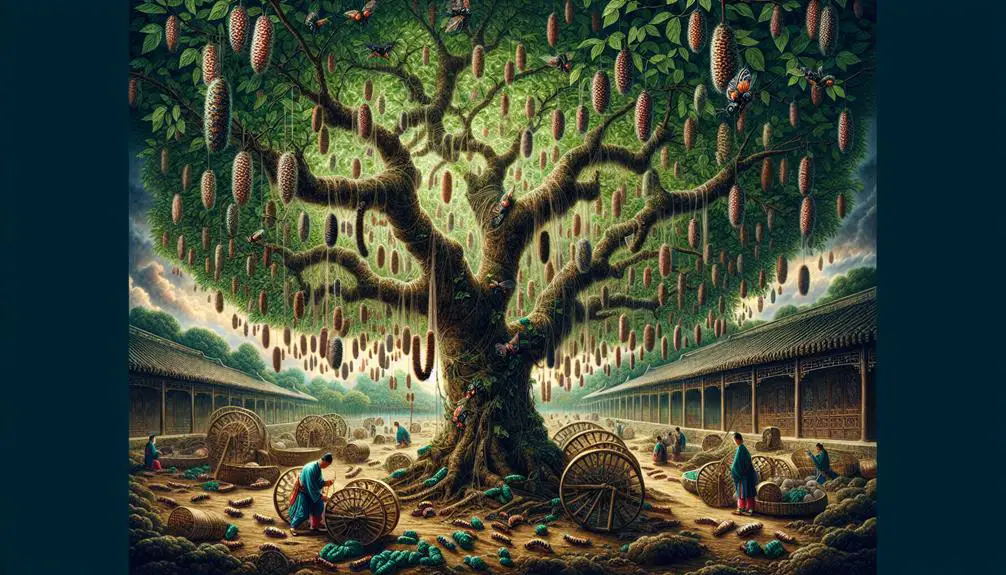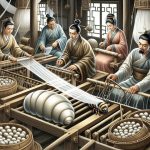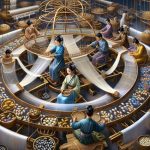Silk originated in ancient China around 2700 BCE. China held secrets about sericulture techniques and dominated global trade. Silk's history is rich and enthralling, revealing tales of luxury and economic power. Dig deeper into the origins of this luxurious fabric to uncover a world of ancient craftsmanship and cultural significance.
Table of Contents
Key Takeaways
- Silk production originated in ancient China around 2700 BCE.
- Sericulture evidence found in Nancun, Hebei.
- Silk reached ancient Khotan by the 1st century CE.
- Silk industry expanded to Western Europe by the 6th century CE.
- Lady Hsi-Ling-Shih discovered silk production around 3000 BC.
Ancient Chinese Origins
In the ancient Chinese civilization, the beginnings of silk production can be traced back to around 3000 BC, according to Chinese legend. Silk, a luxurious and highly desired fabric, was initially created in ancient China through the practice of sericulture. This complex process involved raising silkworms, specifically the Bombyx mori species, to harvest their silk-producing cocoons.
The evolution of silk production in ancient China was greatly influenced by the shift from the wild silk moth species, Bombyx mandarina, to the domesticated Bombyx mori. This change allowed for the controlled and efficient production of silk, leading to the establishment of sericulture as an essential industry.
Chinese civilization thrived with the introduction of silk production, with Lady Hsi-Ling-Shih often acknowledged for sharing the secrets of sericulture with the people. These techniques were closely guarded, giving China a monopoly on silk production for centuries and solidifying its reputation as the premier source of this opulent fabric.
Lady Hsi-Ling-Shih Legend
With the discovery of silk attributed to Lady Hsi-Ling-Shih in Chinese legend, a fascinating tale unfolds of how this luxurious fabric became intertwined with ancient Chinese culture and economy.
Lady Hsi-Ling-Shih, the wife of the Yellow Emperor Huangdi in ancient China, is credited with uncovering the secrets of silk production around 3000 BC. According to the legend, she learned about silk by observing silkworms spinning fibers in mulberry trees.
This discovery marked a pivotal moment in history, as silk went on to play a significant role in shaping Chinese culture and economy. The mystical origins of silk, as depicted in the legend of Lady Hsi-Ling-Shih, highlight the reverence and importance attached to this precious fabric throughout Chinese history.
Lady Hsi-Ling-Shih's contribution to silk production showcases the ingenuity and resourcefulness of ancient civilizations in harnessing nature's gifts for their benefit.
Archeological Evidence of Sericulture
Archaeological findings provide compelling evidence of sericulture dating back 6000-7000 years, shedding light on the ancient origins of silk production. The discovery of silk production in Nancun, Hebei, marks the earliest known evidence, while silk cultivation in South Asia can be traced back to the Yangshao period.
By the 1st century CE, silk had already reached ancient Khotan, showcasing its widespread presence. Additionally, the Neolithic period in China, over 8,500 years ago, saw the beginnings of silk production, indicating its deep-rooted history in the region.
The artifacts unearthed at these sites offer tangible proof of the intricate processes involved in sericulture, revealing the meticulous craftsmanship of ancient civilizations.
Evolution of Silk Moth Species
I'll start by shedding light on the fascinating evolution of silk moth species.
The diversification of silk moths, the variations in silk based on geographical location, and the environmental adaptations of these remarkable creatures are all essential aspects to explore.
Understanding how silk moths have evolved over time can provide valuable insights into the intricate world of silk production.
Silk Moth Diversification
During the evolution of silk moth species, the original Bombyx mandarina Moore transformed into Bombyx mori through selective breeding and cultivation by ancient Chinese sericulturists.
The domesticated silk moth, Bombyx mori, is well-known for its production of high-quality silk. The selective breeding practices led to the development of specialized silk-producing moths, enhancing the efficiency and quality of silk production.
This diversification in silk moth species allowed for the creation of more superior silk varieties, revolutionizing the silk industry.
The ancient Chinese sericulturists played a pivotal role in this transformation, paving the way for the production of exceptional silk fabrics.
Geographic Silk Variations
Silk production has evolved considerably due to geographic variations in silk moth species. The original silk moth species, Bombyx mandarina Moore, transformed into Bombyx mori, which played a key role in the development of silk production. This evolution occurred as a result of domestication for silk production, particularly in China where silk production originated.
Different regions house variations of silk moth species, leading to diverse silk qualities. These geographic variations influence the characteristics of silk fibers, ultimately contributing to the wide array of silk fabrics available today. The evolution of silk moth species has been instrumental in the advancement of silk production and the variety of silk fabrics that we enjoy.
Environmental Adaptations
Geographic Silk Variations have influenced the evolution of silk moth species, leading to Environmental Adaptations that highlight their reliance on human intervention for survival and reproduction.
Silk moth species, such as Bombyx mandarina Moore evolving into Bombyx mori through selective breeding, showcase this dependence. The loss of flight and natural mating abilities in Bombyx mori due to domestication illustrates their adaptation to human care.
Specialized silk glands in silk moth caterpillars, developed through evolution, aid in spinning cocoons with precision. These environmental adaptations have made silk moths reliant on humans for their life cycle, emphasizing the intricate relationship between silk production and human intervention.
Secrets of Sericulture Guarded
Guarding the secrets of sericulture was a paramount task in ancient China to safeguard the nation's monopoly on silk production. Chinese emperors went to great lengths to make certain that the techniques of silk production, such as silkworm rearing and silk extraction, remained state secrets. The severe consequences for revealing these secrets, including death, underscored the importance of maintaining China's dominance in the lucrative silk market. Those who dared to betray these secrets risked not only their lives but also the economic stability of the nation.
The strict enforcement of these laws helped China maintain its stronghold over silk production for centuries, allowing the nation to control the silk trade and reap the benefits of this highly sought-after commodity. The secrecy surrounding sericulture practices was a key factor in China's ability to retain its monopoly and thrive in the competitive world of silk manufacturing. The heritage of these guarded secrets continues to be a tribute to the power of knowledge protection in sustaining economic supremacy.
Silks Economic Significance in China
Silk had a deep impact on ancient China's economy, contributing greatly to its wealth and influence.
The growth of trade routes like the Silk Road was driven by the flourishing Chinese silk industry.
The imperial government's strict control of silk production maintained quality and secured China's dominance in the global silk market.
Silk Trade Routes
With its intricate weaving of economic power and cultural influence, the trade routes of silk in ancient China formed the backbone of a thriving global commerce network.
- Chinese silk was a highly sought-after commodity traded along the Silk Road for gold, ivory, and precious stones.
- Silk production in China bolstered the country's wealth and prominence in global trade networks.
- Emperors of China utilized silk as diplomatic gifts to establish alliances and secure advantageous trade agreements.
- The Silk Road played a pivotal role in disseminating Chinese silk culture, craftsmanship, and luxury goods to distant lands.
- The exchange of Chinese silk through these trade routes not only enriched the nation but also facilitated the spread of its influence and opulence across borders.
Silk Production Centers
Nestled within the heart of ancient China, bustling with activity and innovation, were the renowned silk production centers that shaped the economic landscape of the region. China, holding a monopoly on silk production for centuries, excelled in creating high-quality silk products.
Cities like Hangzhou and Suzhou became synonymous with exquisite silk craftsmanship, contributing noticeably to the economic importance of silk in China. The art of sericulture flourished in these centers, with specialized techniques and traditions developed over time.
Silk from China not only symbolized luxury and wealth but also became a key driver of economic growth, attracting traders and buyers from far and wide. The legacy of these silk production centers continues to influence the global silk industry today.
Silk Industry Growth
Amidst the vibrant tapestry of ancient China's economic evolution, the exponential growth of the silk industry reverberated with undeniable significance. The silk industry's expansion was characterized by:
- Silk Trade Routes: Silk trade routes such as the Silk Road facilitated the exchange of raw silk and silk garments, enhancing economic growth.
- Imperial Control: The Chinese imperial court tightly regulated silk production, elevating its exclusivity and value.
- Diplomatic Influence: Silk was utilized as a form of currency and a diplomatic gift, showcasing China's economic power.
- Byzantine Influence: Byzantine silk production techniques influenced Chinese silk weavers, enriching the quality of silk fabric.
- Global Demand: The demand for Chinese silk in Rome and the West had substantial economic implications, shaping trade dynamics.
Various Uses of Silk
Silk serves a multitude of purposes, ranging from clothing to decoration, showcasing its remarkable versatility throughout history.
In ancient Rome, silk was highly valued and became popular among all classes by 380 AD. Emperor Heliogabalus was known for wearing only silk garments, emphasizing its luxurious status. The demand for silk in Rome led to it being a coveted commodity, causing economic strain due to the reliance on imported silk. Even barbarian tribes felt the influence of silk, as seen during Alaric's siege of Rome in 408 AD.
Byzantium played a significant role in the history of silk, monopolizing silk production and mastering weaving techniques by the 6th century. This dominance impacted the market for Chinese silk and shaped the silk industry for centuries to come.
The versatility of silk extended beyond clothing, being used for decoration, musical instruments, and even paper, highlighting its importance in various aspects of human life.
Evolution of Silk Production Techniques
With advancements in Chinese looms and weaving techniques, the evolution of silk production has witnessed remarkable improvements over the centuries. Chinese looms, such as drawlooms and pedal looms, have long been revered for their superior capabilities in silk production techniques. These innovative looms, dating back to the 2nd century BC, paved the way for the weaving of intricate silk brocades and luxurious damasks, setting a high standard for quality in the industry.
The Byzantine silk industry also gained renown for its exquisite weaving and elaborate decorative patterns, showcasing the artistry and skill involved in silk production. As technology progressed, water-powered mills became increasingly prevalent, revolutionizing the production process and enhancing efficiency in creating silk fabrics.
The combination of traditional craftsmanship and modern advancements continues to shape the world of silk production, ensuring the legacy of this ancient art form endures.
Global Spread of Sericulture
I'll now guide you through the fascinating journey of silk's global spread, touching on Silks Ancient Origins, Silk Road Trade, and Modern Silk Production.
Let's explore how this luxurious fabric revealed borders, connecting distant lands through trade and cultural exchange.
The evolution of sericulture discloses a rich tapestry of history, innovation, and craftsmanship that continues to shape the world today.
Silks Ancient Origins
Tracing back to ancient China around 2700 BCE, the origins of silk production reveal a fascinating journey of global spread through sericulture. The ancient site of Nancun in Hebei provides evidence of early silk cultivation. Silk's reach extended to South Asia during the Yangshao period, indicating its global expansion. By the 1st century CE, silk had made its way to ancient Khotan, highlighting the extensive trade routes involved. The silk industry continued its spread, reaching Western Europe by the 6th century CE, underscoring its global significance.
- Silk production originated in ancient China around 2700 BCE.
- Evidence of sericulture was found in Nancun, Hebei, showcasing early silk cultivation.
- Silk spread to South Asia during the Yangshao period, indicating its global expansion.
- By the 1st century CE, silk had reached ancient Khotan, demonstrating its extensive trade routes.
- The silk industry further spread to Western Europe by the 6th century CE, showcasing its global significance.
Silk Road Trade
The Silk Road played a pivotal role in the global dissemination of sericulture, enabling silk production to extend far beyond the borders of ancient China. Through silk road trade, sericulture practices were shared, leading to silk cultivation in regions like Korea, Japan, India, and even the Roman Empire.
Dating back to at least the 2nd century BC, Chinese silk trade was well-documented, with evidence found in Egyptian mummies and historical accounts. The exchange of silk along these trade routes not only influenced economic development but also fostered cultural exchange between different regions.
This network of trade routes facilitated the spread of silk production techniques, allowing the silk industry to flourish in diverse parts of the world, shaping the course of history.
Modern Silk Production
Modern silk production has expanded globally, with key players including China, Japan, India, and Italy leading the industry. Countries like Brazil, Thailand, and South Korea have also embraced sericulture. China dominates the global market share, accounting for over two-thirds of silk production.
India excels in mulberry silk, making significant contributions to the industry. Modern techniques have evolved to meet the increasing global demand for this luxurious fabric. The silk industry continues to thrive, with innovations and advancements ensuring the quality and sustainability of silk production worldwide.
Modern Silk Industry
Amidst global competition and technological advancements, the silk industry continues to flourish, driven by key players like China, Japan, South Korea, and Thailand.
China, as the largest raw silk producer, dominates the market with over two-thirds of the global share. Despite facing competition from synthetic fibers, the modern silk industry remains strong. Louis Pasteur's discovery of a silkworm plague in 1865 revolutionized silk production methods, contributing to the industry's evolution.
Japan's advanced sericulture techniques have solidified its position as a significant raw silk supplier. South Korea and Thailand also play essential roles in the modern silk industry, collectively shaping the global landscape of silk production. Through innovation and strategic investments, these countries have sustained the industry's growth and relevance in the face of changing market dynamics.
The modern silk industry stands as a proof and crucial part of the resilience and adaptability of traditional practices in the contemporary world.
Frequently Asked Questions
Who Brought Silk Out of China?
I brought silk out of China. My actions led to the spread of silk production techniques beyond China's borders. This sharing of sericulture secrets facilitated global expansion of silk production, impacting regions far beyond China.
Silk Comes From Silkworms, Which Are the Larval Form of the Silk Moth
Silk comes from silkworms, the larval form of the silk moth. They produce silk through their salivary glands, creating cocoons spun from silk filament. The degumming process removes sericin, a sticky substance, revealing the lustrous silk threads.
Where Does the Most Silk Come From?
Most silk in the world comes from China, the largest producer globally. China's extensive silk production accounts for over two-thirds of the world's silk output. India, Japan, Italy, and Brazil also play significant roles in silk production.
How Long Did China Keep Silk a Secret?
China kept the secret of silk production for over 2,000 years. Maintaining the monopoly on silk helped China's economy thrive. The luxury commodity was in high demand, and its trade on the Silk Road enriched China both economically and culturally.
- What Is Ameri-Suede Fabric? - July 12, 2025
- How to Clean Fake Suede Fabric Effectively - July 12, 2025
- What Is Suede Knit Fabric? - July 12, 2025







